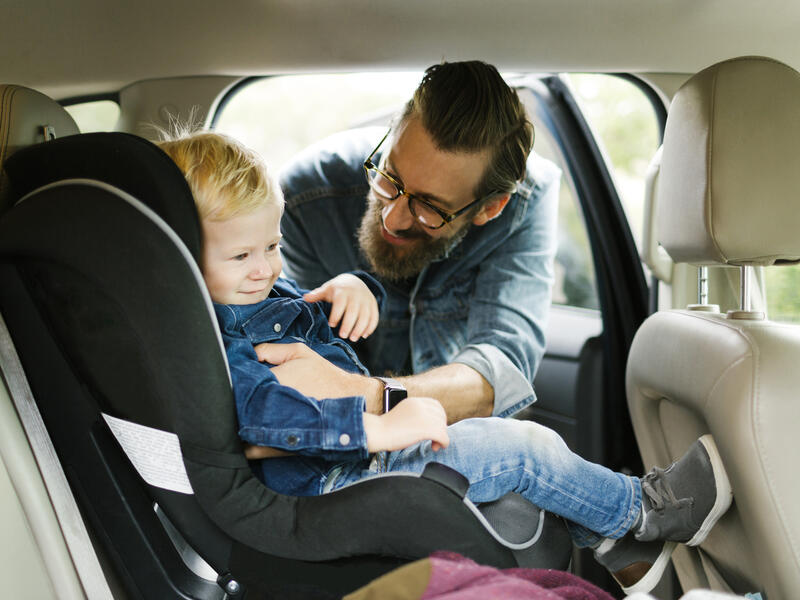Is your child as safe as they could be in the car?
Researchers who observed children riding in cars found 46% of car seats and booster seats are used incorrectly in a way that could reduce their effectiveness. Car seat misuse estimates are even higher at 59% when booster seats are excluded.
Car seat recommendations can be daunting. Let’s hit some highlights and get you a resource to keep your little one as safe as possible in the car.
Check your seat: Car seat inspections at Sanford Children’s Safety Centers
Best car seat for infants (newborns to 9 months)
Most children less than 9 months of age fit well in a standard, rear facing infant car seat. These are often the models that can be clipped in and out of your vehicle. The base, which stays in the vehicle, is a great way to ensure your child is secure each time you clip the seat in.
Many seats advertise high weight limits, but it’s also important to watch length as many seats only fit children up to 30 or 32 inches. This height is often reached before a child turns one. The “all-in-one” seats positioned rear facing also work for this age group.
Best car seat for toddlers (under 3 years old)
One of the biggest changes to car seat recommendations in the last few years is that children should be rear facing until at least 2 years of age. This recommendation is based on good evidence showing the rate of head, neck and brain injury is much higher in young children who face forward. As our cars decelerate in serious accidents their little necks have a tough time slowing down their larger heads.
The convertible or stage 2 car seats work well for this. They can safely face backwards for some time. The LATCH system (now in most cars) or the seat belt can be used to secure the seat.
Best car seat for preschoolers (ages 3-5)
Children who have outgrown the rear facing height or weight of their convertible seat should sit forward facing. This would be with a seat with a five-point harness (the seats with the chest clip and the two buckles by the legs). This can be a convertible or forward facing seat.
This seat should be used until your child outgrows the height or weight. This is one of the most common mistakes parents make. They really are safest in these harness systems as long as you can keep them there.
Best car seat for school-aged children (ages 5-11)
The time to move to a booster is specific for each child but may not be until well after your child starts school, especially with many new larger seats.
Once they are too large for their five-point harness, then a belt positioning or traditional booster is best. This should be used until your child is 4 feet 9 inches tall. This is usually between 8 and 11 years of age.
While this may seem like a very long time for them to use a seat, it is safest. Children in this age group have less developed bone structure than adults who the seat belt was designed for. The growing bones are more pliable and ensuring the belt is positioned low on the hips, and across the breastbone, greatly decreases the risk of serious injury.
Best car seat for middle school (ages 11-13)
Yep, you read that right — middle school. Your child should sit in the back seat of the vehicle whenever possible until the age of 13. Again this is due to car design and safety features, specifically front air bags and the risk of injury to front seat passengers in the event of a crash.
Little known facts about car seat safety
- Thick coats and snowsuits can significantly decrease the safety of a seat. It’s best to buckle your child in without one of these on and then put the coat on before you go out.
- Car seats expire! They shouldn’t be used after the expiration date. They usually expire six to 10 years after they were manufactured.
- A car seat that is installed in a car (with or without a child in it) at the time of a moderate or severe accident should be replaced.
- You can get your car seat checked at your local fire station or other community resources to ensure it is properly installed.
- Installation can be tricky. The LATCH system is often most effective to keep the seat secure. However, these systems have weight limits as low as 65 pounds (combined weight of the child and the seat). As your little one becomes not so little, check your vehicle information to know when to switch to the seat belt.
- If you are using a car seat facing forward, the LATCH should be used across the back of the seat regardless of whether you use the belt or the LATCH to secure the front of the seat.
To keep your precious cargo as safe as possible, they should be in the correct seat, in the correct position, with the seat installed correctly at all times when the vehicle is moving.
A lot of parents ask about the best brand of car seat. A well-installed, less expensive seat is far more effective than the highest end car seat can ever be.
Learn more
- Turning your child’s car seat to face forward can wait
- Look in back before you lock your car — every time
- Keeping your kids safe and warm in winter
…
Posted In Children's, Health Information, Healthy Living, Parenting
